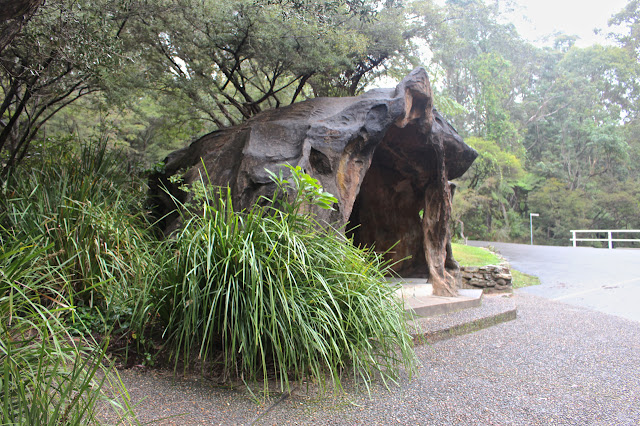There are a couple of grottoes I failed to photograph while living in the Blue Mountains, namely the dilapidated one that exists on a track down a hill behind the Katoomba Falls Kiosk near Scenic World in Katoomba. When I did my talk on grottoes in 2015 at Pecha Kucha (grotto talk), a young boy told me about it, and how he has turned into his own private cubby house. There's also another grotto in the lower mountains on a walking track that I lost the directions to that someone else told me about - bad bad researcher!
So, if anyone cares to continue with photos for this blog, send me an email and I'll post them here and credit you: thecarrotjoke[at]gmail.com
Also, my blog about my arts practice and 'deathie' stuff is here: www.thecarrotjoke.blogspot.com
Thanks, it's been fun!
P/S
I wrote extensively about grottoes in my Masters exegesis (still being assessed), from their history in Baroque landscape architecture and as devotional grottoes - aswell as discuss my own use of the grotto in my practice and other artists who have used the grotto in their work. Here's a little snippet particularly about the Blue Mountains grottoes that may be of interest, cut and paste from my exegesis:
------------------------
Colonial Australian landscape design adopted the English Landscaping School of the 1800s. The ‘Picturesque Movement’ eradicated geometric designs and embraced designs that replicated nature.[1] This familiar design served English settlers well as the recognisable English foliage mitigated homesickness. Building a grotto on one’s property was often part of this plan and so the grotesque also made its way into Australian landscape design.
The Blue Mountains in New South
Wales hosts a number of artificial grottoes (known locally as picnic huts)
sitting silently in town parks
and deteriorating slowly from concrete cancer. Here, they are not found in
private gardens but exist in public parks. The history of these grottoes dates
back to the post-WWII period when teams of returned servicemen were put to work
to create picnic huts and shelters particularly in the upper Blue Mountains
towns of Katoomba and Leura. The creation of the grottoes, which were made from
cement-rendered steel, was most likely led by Tom Adams.[2] Adams was a
landscape designer who also built similar structures at Taronga Park Zoo,
notably Monkey Hill that now houses mountain goats [see figure above]. There is
scant information on Tom Adams and his projects in the Blue Mountains. The Blue
Mountains City Council and local historians are aware of his importance to
local history yet little documentation exists on record.
[1] Hambrett, J 2006, Rise of the Australian Plant Garden, A Short History of Australian
Garden Design, viewed 25 July 2015, http://anpsa.org.au/design/rise.html
[2] Mount Victoria, The Crossing Town on the Edge, Mount
Victoria Memorial Park, the grottos and the war memorial, viewed 25 July 2015, http://mountvictoria.org.au/our-great-places/the-imperial-park-zoo
Image credit: Mandy G., Goat Hill, Taronga Zoo, Sydney, 2014, digital image, viewed 1 July 2015, http://www.tripadvisor.com/LocationPhotoDirectLink-g552107-d257406-i91334615-Taronga_Zoo-Mosman_Greater_Sydney_New_South_Wales.html
Image credit: Mandy G., Goat Hill, Taronga Zoo, Sydney, 2014, digital image, viewed 1 July 2015, http://www.tripadvisor.com/LocationPhotoDirectLink-g552107-d257406-i91334615-Taronga_Zoo-Mosman_Greater_Sydney_New_South_Wales.html



























